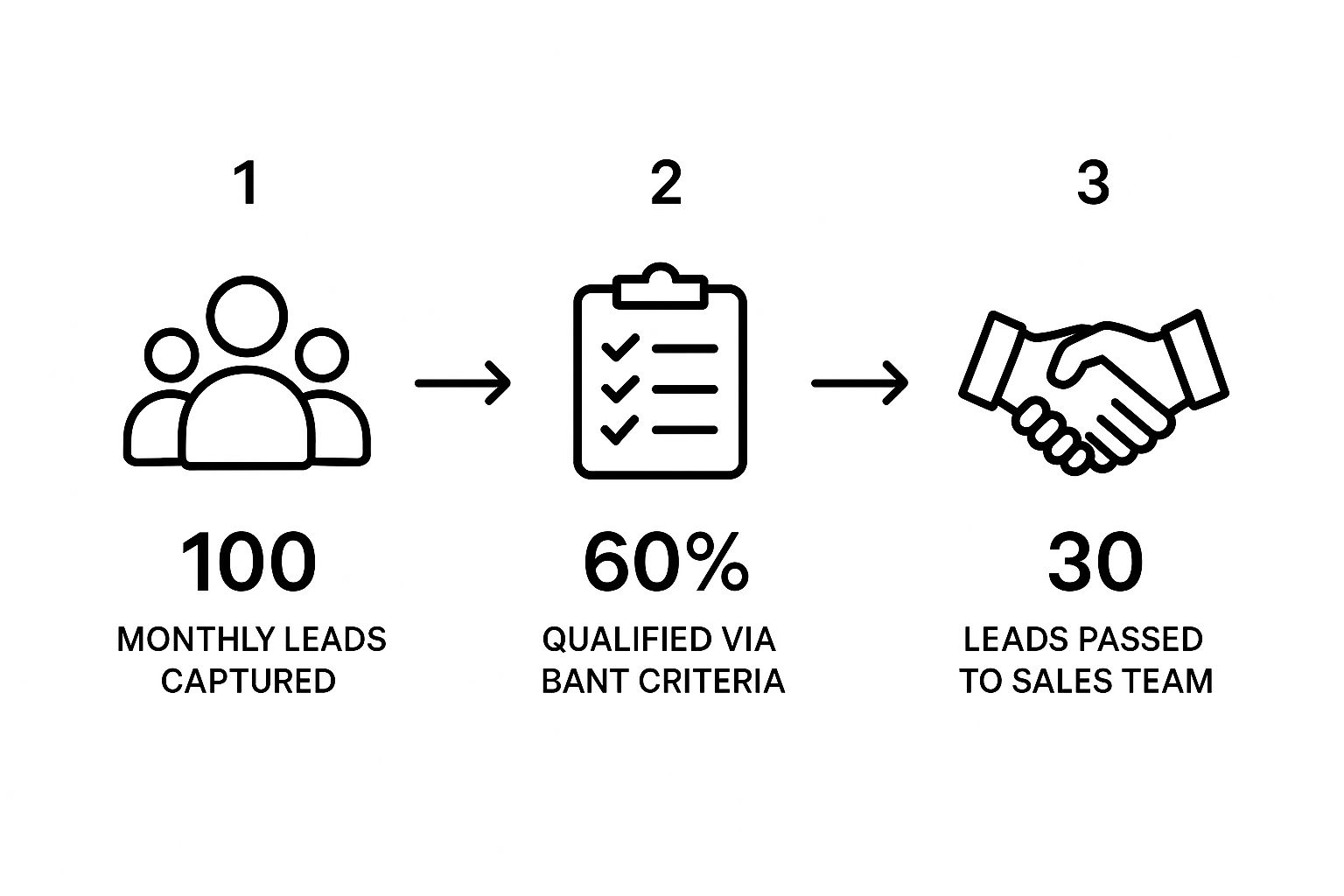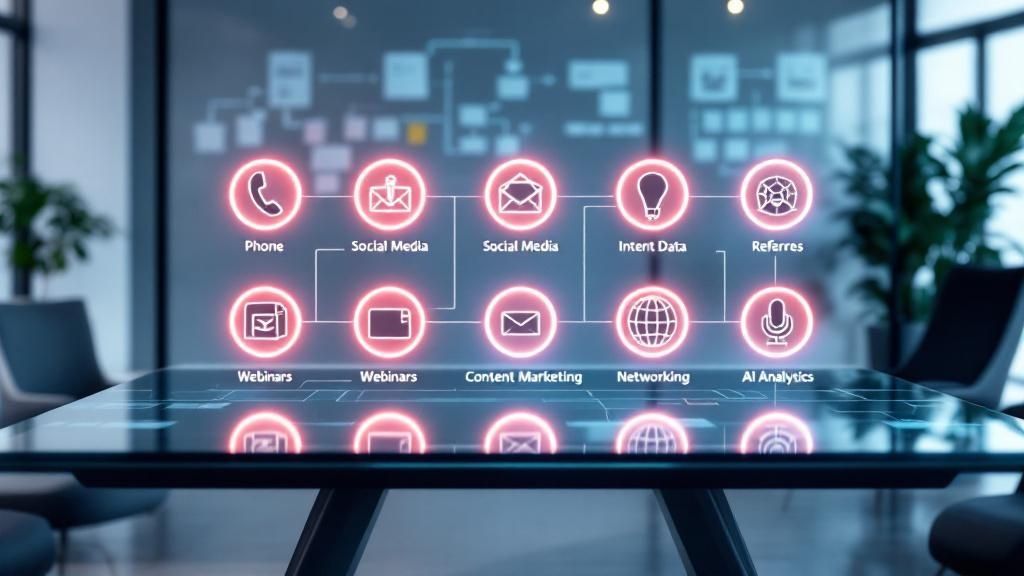Every great sales strategy starts with a solid plan. Think of building a sales pipeline as a three-part mission: first, you need to know exactly who you're selling to (your ideal customer profile). Second, you map out the specific steps in your sales process. Finally, and most importantly, you keep that pipeline filled with qualified leads.
This isn't about guesswork. It's about building a predictable revenue machine.
Your Blueprint for a High-Converting Sales Pipeline

Before we jump into the hands-on details of data, sequences, and automation, let's get one thing straight. A modern sales pipeline is so much more than a glorified to-do list or a dusty old spreadsheet. It’s the central nervous system of your entire revenue operation—a living, breathing system designed to guide prospects from that first "hello" to a closed deal with total clarity.
The old way of working—scattered notes, forgotten follow-ups, deals tracked on a whim—is a recipe for lost opportunities. A high-performing pipeline, on the other hand, is your visual, actionable map. It’s not just for tracking deals; it's for actively pushing them over the finish line.
The Foundational Pillars of Pipeline Construction
You can't just throw a bunch of leads at a wall and hope something sticks. Building a pipeline that actually works requires a strategic framework. It’s like building a house—if the foundation is shaky, the whole thing will eventually come crumbling down.
Here are the non-negotiables:
- Ideal Customer Profile (ICP): This is your true north. You absolutely have to know who you're selling to. A crystal-clear ICP ensures you’re not wasting time and are filling your pipeline with prospects who are a perfect fit for what you offer.
- Defined Sales Stages: These are the key milestones in your prospect's journey. Having clear entry and exit rules for each stage is what keeps deals from going stale and gives your team a shared language for what's happening.
- Quality Lead Sources: Your pipeline is only as good as the leads you pour into it. Finding reliable, consistent sources of high-intent prospects is what keeps the engine running.
- The Right Technology: Let's be honest, modern sales runs on smart tools. A platform like Salesloop.io acts as the engine for your entire process, handling the repetitive outreach, tracking engagement, and giving you the data you need to make smart decisions.
A well-structured sales pipeline isn’t just a tool for sales reps; it’s a strategic asset for the entire business. It provides forecasting accuracy, highlights process bottlenecks, and ultimately creates a predictable path to revenue growth.
This initial blueprint is what everything else is built on. The market for sales pipeline software was valued at a massive USD 3.8 billion in 2023 and is on track to hit USD 10.2 billion by 2032. What does that tell you? It shows a huge industry-wide shift toward data-driven, automated sales. You can read more about these sales software market trends here.
Nailing these fundamentals from the start is how you build a pipeline that doesn't just manage deals, but actively helps you win more of them.
To make this even clearer, here’s a quick breakdown of the core components we’ve just discussed.
Core Components of a Modern Sales Pipeline
This table summarizes the essential pillars for building a robust B2B sales pipeline, providing a quick-reference guide to the key concepts discussed in this article.
| Component | Description | Key Action |
|---|---|---|
| Ideal Customer Profile (ICP) | A detailed definition of your perfect customer, including industry, size, pain points, and role. | Research and document the specific characteristics of your best-fit customers. |
| Defined Sales Stages | The specific steps a prospect moves through, from initial contact to a closed deal. | Map out your sales process and set clear entry/exit criteria for each stage. |
| Quality Lead Sources | The channels and methods you use to find and attract potential customers. | Identify and prioritize the most effective lead sources for your ICP. |
| The Right Technology | The software and tools used to automate, track, and analyze pipeline activity. | Implement a tool like Salesloop.io to automate outreach and manage your pipeline. |
Keep these pillars in mind as you move through the next steps. They are the bedrock of a predictable, high-growth sales motion.
Fueling Your Pipeline with High-Quality Data

The dashboard above gives you a glimpse of what a healthy, active pipeline looks like inside Salesloop.io—multiple campaigns, all humming along, engaging carefully segmented lists. But how do we get there?
There's an old saying in sales: "garbage in, garbage out." It’s a cliché for a reason. The success of your entire sales pipeline hinges completely on the quality of the data you feed it. Let's get practical, though. Building a powerful pipeline doesn't start with the first email. It starts with sourcing and prepping lead data that actually gives your outreach a fighting chance.
Get this part right, and you're not just sending messages; you're starting conversations with the right people at the right time.
Sourcing Your Ideal Prospects
Before you can build those hyper-targeted lists, you need a solid, reliable stream of prospects. This means you first have to get crystal clear on your ICP and master the art of identifying your ideal target audience. If you don't know exactly who you're selling to, even the world's best data sources won't save you.
Once you know who to look for, you can start looking in the right places.
- B2B Data Providers: Platforms like ZoomInfo, Lusha, or Apollo.io are goldmines. They offer deep firmographic data (think company size, industry, revenue) and contact details, letting you build out initial lists that match your ideal customer profile.
- LinkedIn Sales Navigator: Honestly, this is probably the most powerful tool out there for B2B prospecting. Its advanced filters are incredible. You can zero in on decision-makers by job title, seniority, company headcount—even recent job changes or company news. You can build incredibly specific lead lists right inside the platform.
- Intent Data Platforms: This is where things get really interesting. Tools like Bombora or G2 track online "buying signals"—like when a company starts researching solutions just like yours. This data is pure gold because it tells you who is actively in-market, which makes your timing and messaging so much more relevant.
The goal isn't just to find any data; it's to find the right data. A pro move is to combine sources. For instance, use Sales Navigator to identify the perfect prospects, then use a data provider to enrich that list with their verified email addresses.
From Raw Data to Actionable Segments
Here’s a common mistake: dumping a massive CSV file straight into your outreach tool and hitting "send." That's a one-way ticket to low engagement. The real magic, and a core function of a platform like Salesloop.io, is in enrichment and segmentation. This is how you turn a generic list into a collection of targeted micro-audiences.
Instead of blasting one generic message to 1,000 marketing managers, you can create specific segments based on what you know about them.
| Segmentation Type | Example Criteria | Why It Matters |
|---|---|---|
| Firmographic | Industry (SaaS), Company Size (50-200), Region (NA) | Lets you tailor messaging around industry-specific pain points and language. |
| Technographic | Uses HubSpot, Salesforce, or Marketo | Allows you to mention their current tech stack and position your tool as an integration or improvement. |
| Behavioral | Downloaded an ebook, visited the pricing page | Shows they're actively interested. This justifies a more direct and timely follow-up. |
When you break your list down like this, you can write personalized outreach that actually connects. A message written for a "Marketing Manager at a 50-person SaaS company using HubSpot" is going to land a thousand times better than a generic blast.
A well-segmented list is the bedrock of modern B2B sales lead generation. It's the difference between shouting into a void and having a real conversation with someone who's ready to listen. For more on this, check out our guide on B2B sales lead generation.
This whole process—sourcing, enriching, and segmenting your data—is the essential prep work. It’s what ensures every step that follows, from writing your sequences to setting up automation, is built on a solid foundation of relevant, high-quality prospects. Skip this, and you’re just creating more noise.
Designing Pipeline Stages for Maximum Momentum
A well-fueled pipeline is a fantastic start, but a poorly defined one is where promising deals go to die. This is the moment you translate sales theory into a practical, visual workflow. The key to keeping deals moving and avoiding stalls is to create clear, logical pipeline stages that actually mirror how you sell.
Forget generic templates. Sure, common stages like ‘Lead In,’ ‘Contact Made,’ and ‘Meeting Scheduled’ offer a decent baseline, but the real power comes from tailoring them to your business. The goal is a system where every single person on your team knows exactly what needs to happen to push a deal forward.
Defining Your Core Sales Milestones
First things first: stop thinking about a "pipeline" and start thinking about your customer's journey. What are the key moments of commitment or progress that happen between their first spark of interest and the final handshake? Those are your natural stage markers.
When you're trying to build momentum, using digital customer journey mapping can be a goldmine for understanding your prospects' paths and pain points. Mapping this out helps you sync your sales actions with your prospect’s own decision-making process.
For a typical B2B SaaS company, a customized pipeline might look something like this:
- New Lead: A prospect is identified and imported into Salesloop.io, but we haven't reached out yet.
- Engaged: The prospect has opened an email, clicked a link, or replied. This is our cue to move from an automated sequence to a more personal follow-up.
- Meeting Booked: A discovery call or demo is on the calendar. This is a huge milestone and a strong signal of qualification.
- Qualified to Buy: After the first meeting, we’ve confirmed they have the Budget, Authority, Need, and a Timeline (BANT) to buy.
- Proposal Sent: A formal proposal detailing the solution and pricing has been sent to the decision-maker.
- Negotiation: We're in active discussion about contract terms, pricing, or implementation details.
- Closed Won / Closed Lost: The final outcome.
This structure gives you a crystal-clear, at-a-glance view of your deal progress and overall health.
The Power of Firm Entry and Exit Criteria
This is where most sales teams drop the ball. A stage name means nothing without clear rules. Firm entry and exit criteria are the non-negotiable definitions of what must happen for a deal to enter a stage and what must happen for it to leave.
Think of these criteria as the gatekeepers of your pipeline. They prevent reps from moving deals forward based on "gut feelings" and ensure every stage reflects a real, verified step in the sales process. This discipline is essential for accurate forecasting.
Let’s put this into practice for our ‘Meeting Booked’ stage:
- Entry Criteria: The prospect has to accept a calendar invite for a specific date and time. Period.
- Exit Criteria (to Qualified): The meeting happened, and the rep successfully verified at least three of the four BANT components.
- Exit Criteria (to Lost): The prospect was a no-show after one reschedule attempt, or they flat-out said they weren't a fit during the call.
Without these rules, your pipeline becomes a subjective mess, making it impossible to spot where things are really getting stuck. A visual process flow can even help illustrate this qualification funnel before deals hit the main pipeline. This infographic shows a common scenario where leads are vetted before being handed off to sales.

This visualization really drives home a crucial filtering process: of the initial 100 leads captured, only the 30% that meet strict qualification criteria are considered worthy of the sales team's time and focus. Building these stages and rules within a tool like Salesloop.io turns this framework from a static document into an interactive, real-time dashboard, giving you a powerful, immediate read on your sales health.
Automating Outreach with Smart Sales Sequences

Let's be honest: relying on manual follow-up is a fast track to missed opportunities and a burned-out sales team. Once you’ve got your pipeline filled with high-quality, segmented data, the real work begins—engaging those prospects at scale without sounding like a robot. This is where smart automation becomes your secret weapon.
We’re not talking about just blasting generic emails to your entire list. That’s just spam with extra steps. Instead, we’re going to build intelligent, multi-step sales sequences that feel personal, nurture leads consistently, and even adapt to how they behave. It’s how you turn a static spreadsheet into a dynamic engagement engine.
Crafting Your Multi-Touchpoint Campaign
An effective outreach sequence is so much more than a string of emails. Think of it as a choreographed campaign, carefully planned to use multiple touchpoints over a set period. The goal here is to stay top-of-mind without being a nuisance, all while providing genuine value at each step.
A solid sequence almost always blends different channels. While Salesloop.io crushes email automation, a truly comprehensive strategy will weave in other actions.
- Email Touchpoints: This is the backbone of your sequence. Each email needs a single, clear purpose—whether that's sharing a compelling case study, asking a sharp question, or offering a quick demo.
- LinkedIn Engagement: Before you even send the first email, a strategic LinkedIn connection request or a thoughtful comment on a prospect's post can warm them up. It’s a simple move that makes a huge difference.
- Phone Calls: For your high-value prospects, a well-timed call can cut right through the digital clutter. I’ve found this works best for leads who have already shown some engagement, like clicking a link in one of your emails.
The key is to establish a natural rhythm. For example, you might start with a LinkedIn connection on Day 1, follow up with an intro email on Day 3, and then share a helpful resource in another email on Day 6.
Writing Email Copy That Actually Gets Replies
This is where your personalization efforts really pay off. Using the segmented data you’ve already prepared, you can craft messages that truly connect. Instead of a bland "Hello," you can reference their industry, a recent company milestone, or even a piece of tech they’re using.
A few tips I’ve learned for writing copy that works:
- Lead with their problem, not your solution. Show you understand their world and the challenges they're up against before you start pitching.
- Keep it short and scannable. Use short sentences, bullet points, and plenty of white space. Nobody has time to read a wall of text.
- End with a clear, low-friction call-to-action (CTA). Instead of the high-commitment "Book a demo," try an interest-based question like, "Is improving lead conversion a priority for you right now?"
Pro Tip: Your first email should be all about establishing relevance and credibility. Save the persistence and value-adds for your follow-ups. Don't try to do everything in one message.
Leveraging Conditional Logic for Smarter Outreach
Now for the really cool part. This is where automation elevates your entire process from good to great. Modern platforms like Salesloop.io use conditional logic to make your sequences dynamic, meaning the campaign automatically adjusts based on what a prospect does.
For instance, you can set up simple rules so that if a prospect:
- Replies to an email: They're automatically unenrolled from the sequence, letting a sales rep jump in with a personal response.
- Clicks a specific link (like your pricing page): They can be tagged as a high-intent lead, triggering an instant notification for a rep to follow up.
- Books a meeting via your calendar link: They're immediately pulled from all active campaigns. No more awkward "just following up" emails to someone who has already booked a call.
This kind of intelligent automation ensures you never send an out-of-place message to a prospect who has already taken action. It’s what allows you to scale your outreach without sacrificing the quality of your interactions. In our experience, this is a non-negotiable step to truly automate lead generation, freeing up your team to focus on having conversations, not managing lists.
Sales pros are already feeling the impact. Many now expect AI and automation to save them around 5 hours per week on tedious tasks. Even better, companies embracing these tools are seeing a 10-20% bump in ROI and a 20% drop in human errors. Automation is no longer a nice-to-have; it's a cornerstone of any efficient pipeline. To streamline your own sales process, consider checking out tools like Scribbl For Sales.
By building smart, automated sequences, you create a system that works for you 24/7. It ensures no lead ever falls through the cracks and that every single prospect gets the right message at exactly the right time.
Monitoring Pipeline Health with Metrics That Matter
If you don't measure your sales pipeline, you're guessing. It's as simple as that. A pipeline without data is like driving blind—sure, you're moving, but you have no idea if you're heading toward a cliff or a goldmine. This is where we move past vanity metrics and focus on the key performance indicators (KPIs) that actually signal a healthy pipeline and lead to smart decisions.
This data-first approach is what separates the pros from the amateurs. It turns pipeline management from an art into a science. You’ll see how a dashboard, like the one in Salesloop.io, helps you instantly visualize performance, pinpoint exactly where things are breaking down, and forecast revenue with confidence.
Knowing your numbers is the first step. Improving them is the next.
Going Beyond the Surface Level
It’s easy to get fooled by surface-level numbers that look good on a report but tell you almost nothing useful. A huge number of new leads might feel great, but if none are qualified, it's just noise that wastes your team's time. The real key is to track metrics that show momentum and conversion through your pipeline stages.
Think about it: a high drop-off rate between your 'Contacted' and 'Meeting Scheduled' stages isn't just a number. It's a flashing red light. It’s a clear signal that something in your initial outreach—your messaging, your offer, maybe even your targeting—needs a serious overhaul. These are the kinds of insights that spark real improvement.
A pipeline stuffed with dead-end or unqualified leads creates a false sense of security and completely skews your revenue forecasts. The goal isn't a full pipeline; it's a healthy pipeline full of deals that are actively moving forward.
Monitoring the right data helps you cut through the clutter and focus your team's energy where it will actually make a difference.
Core Metrics for a Healthy Pipeline
To get a true picture of your pipeline's health, you need to look at a handful of critical metrics together. Each one tells a different part of the story. A platform like Salesloop.io is built to bring them all into a single dashboard, so you can stop juggling spreadsheets and start analyzing.
Here are the non-negotiables:
- New Sales Qualified Leads (SQLs) Added: This is the lifeblood of your future revenue, measuring the flow of quality opportunities entering your pipeline. If this number dips, it’s an early warning that your top-of-funnel efforts need a tune-up, fast.
- Stage-by-Stage Conversion Rate: This shows you the percentage of deals that successfully advance from one stage to the next. It’s your best tool for finding bottlenecks. For example, a low conversion rate at the ‘Proposal Sent’ stage might mean your pricing is off or your value prop isn't landing.
- Deal Velocity: How long does it take for a deal to move from first contact to closed-won? That's your deal velocity. If it's slowing down, your sales cycle is getting longer, which directly impacts cash flow and forecasting accuracy.
- Average Deal Size: Knowing the average value of your closed-won deals is fundamental for revenue projections. If this number starts to shrink, you might need to focus on upselling or targeting larger accounts to stay on track.
Tracking these KPIs is the essence of effective sales pipeline reporting, turning raw data into a clear roadmap for action.
Before we talk about review cadence, let's break down the essential metrics you should have on your dashboard.
Essential Sales Pipeline Health Metrics
Tracking the right KPIs is crucial, but knowing how often to check them is just as important. Some metrics need daily attention, while others are better reviewed weekly or monthly to identify broader trends.
| Metric | What It Measures | Tracking Frequency |
|---|---|---|
| New SQLs Added | The volume of qualified leads entering the sales process. | Daily / Weekly |
| Stage Conversion Rate | The percentage of deals moving from one stage to the next. | Weekly / Monthly |
| Deal Velocity | The average time it takes to close a deal (win or lose). | Monthly / Quarterly |
| Average Deal Size | The average monetary value of your closed-won deals. | Monthly / Quarterly |
| Win Rate | The percentage of all opportunities that result in a sale. | Weekly / Monthly |
| Lead Response Time | The time it takes for a rep to follow up with a new lead. | Daily |
This table isn't just a checklist; it's a blueprint for building a predictable revenue engine. By keeping a close eye on these numbers, you can spot problems before they derail your quarter.
Establishing a Rhythm of Review
Data is only useful if you actually do something with it. The best sales leaders I know are religious about daily and weekly metric tracking. This consistent review is the secret to accurate forecasting and better close rates. Things like the number of SQLs added, follow-ups completed, and lead response time are critical—especially since responding within the first hour can skyrocket your conversion rates.
A weekly pipeline review meeting is a great cadence for most teams. It creates a space to talk through stalled deals, share what’s working, and make strategic tweaks on the fly. For individual reps, a quick daily check-in on their personal pipeline metrics is a must. It helps them prioritize their day and ensures no hot lead ever falls through the cracks.
This disciplined, data-driven rhythm is what separates the high-performing sales organizations from everyone else.
Common Questions About Building a Sales Pipeline
As you start putting these strategies into action and building out your own revenue engine, questions are going to pop up. It’s natural. Building a sales pipeline that actually works is a living, breathing process, and even the most seasoned pros are constantly tweaking their approach.
Let's dive into some of the most common questions we get from teams just like yours. Getting these concepts right is a game-changer for getting everyone aligned and speaking the same language.
What Is the Difference Between a Sales Pipeline and a Sales Funnel?
This is easily one of the most common points of confusion out there. People use them interchangeably all the time, but they represent two very different things.
Here’s the simplest way to think about it: the funnel belongs to marketing, while the pipeline belongs to sales.
A sales funnel is more of a concept. It shows the customer's journey from a high level, illustrating how a huge pool of potential leads at the top gets filtered down into a smaller group of actual customers. It’s all about conversion rates from awareness to purchase.
A sales pipeline, on the other hand, is a seller's day-to-day tool. It's the set of concrete, actionable stages a salesperson guides a deal through—from "Qualified Lead" to "Proposal Sent" to "Closed Won." It’s a real-time, visual map of your team's deals, used constantly to manage workflow and forecast what’s coming in.
How Many Stages Should My Sales Pipeline Have?
There’s no magic number here, but a solid rule of thumb for most B2B sales cycles is five to seven stages.
The goal isn't complexity; it's clarity. Your stages should be a direct reflection of the actual milestones in your sales process.
For instance, a pipeline with stages like ‘Initial Contact,’ ‘Qualification,’ ‘Meeting Booked,’ and ‘Proposal Sent’ is effective because each step represents a meaningful jump forward. If you can’t clearly define what needs to happen for a deal to enter or exit a stage, it's probably just clutter.
The real test for any pipeline stage is this: does it answer the question, "What has to happen for this deal to move forward?" If the answer is fuzzy, the stage is too. Keep it clean and focused on action.
We’ve seen it time and time again when helping teams set up their workflow in Salesloop.io: a lean, well-defined pipeline always beats one with a dozen confusing, overlapping stages.
How Often Should I Review My Sales Pipeline?
In a word: constantly. A sales pipeline isn't a "set it and forget it" report. It’s a dynamic tool that needs regular attention to keep deals moving and prevent good opportunities from going cold.
Here’s a rhythm that we see work wonders for high-performing teams:
- Daily for Reps: Every single salesperson should be in their own pipeline first thing in the morning. It’s a quick check-in to prioritize the day’s tasks, see which leads are hot, and make sure no follow-ups slip through the cracks.
- Weekly for Managers: Sales managers should run a formal pipeline review meeting with the whole team once a week. This is where you dig in—assessing deal health, brainstorming ways to get stalled opportunities moving again, and firming up forecasts for the month or quarter.
This simple cadence of daily self-management and weekly team huddles is what transforms a static list of deals into a predictable revenue machine.
What Are the Most Common Mistakes in Pipeline Building?
It's unfortunate, but we see a few common pitfalls that can completely sabotage an otherwise solid sales effort. The good news is that just being aware of them is half the battle.
These are the mistakes that pop up most often:
- Using Bad Data: This is a big one. Starting with inaccurate or old lead info wastes an incredible amount of time and is a total morale killer.
- Vague Stage Definitions: When "Qualified" means something different to each rep, your pipeline data is worthless. You can't forecast, you can't coach, and you can't trust the numbers.
- Inconsistent Follow-up: Letting a warm, engaged lead go cold because you don't have a disciplined follow-up process is like lighting money on fire. It's one of the costliest and most avoidable errors.
- A Cluttered Pipeline: Some reps love to keep their pipeline packed with "maybes" and unqualified leads. This creates a false sense of security and completely skews your metrics, hiding the real story of what’s working and what isn’t.
A dedicated tool, a disciplined process, and a serious commitment to data quality are your best defenses against these all-too-common problems.
Ready to build a sales pipeline that drives predictable revenue? Salesloop.io gives you the tools to automate outreach, manage your stages, and track the metrics that matter. Start building your high-converting pipeline with Salesloop.io today.





